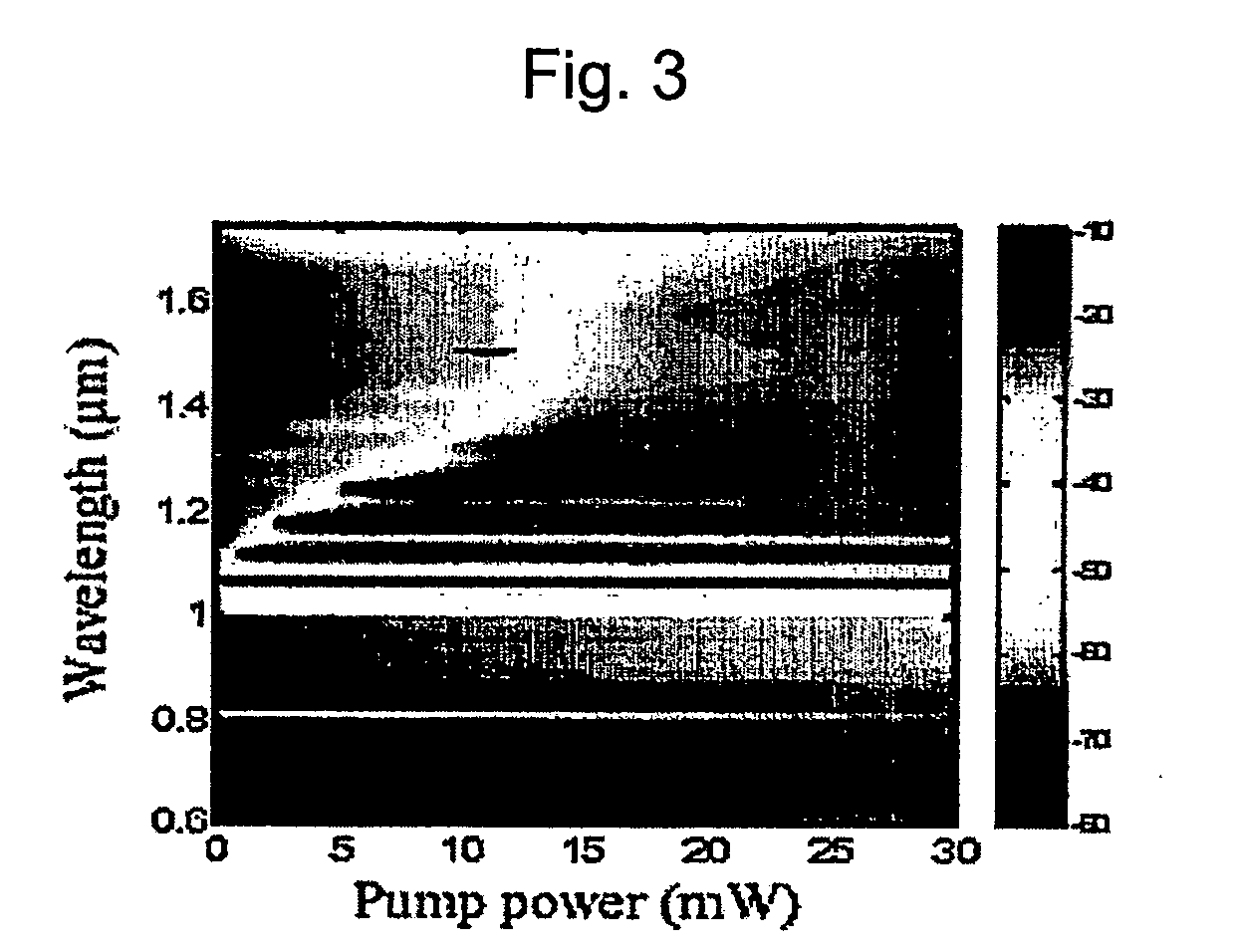Broad spectrum light source
a light source and broad spectrum technology, applied in the field of light sources, can solve the problems of difficult fabrication, inability to move the zero dispersion wavelength, etc., and achieve the effect of compact and inexpensiv
- Summary
- Abstract
- Description
- Claims
- Application Information
AI Technical Summary
Benefits of technology
Problems solved by technology
Method used
Image
Examples
case b
) λpump≦λ0
[0063]PCF L has a measured zero dispersion wavelength λ0=1069 nm. The pump wavelength offset is small, −5 nm, which lies in the region where there is phase matching of widely spaced wavelengths, with little power dependence (FWM, the left half of FIG. 1(b). The dispersion at the pump wavelength is also small, just −1 ps / nm km. The evolution of the measured output spectrum with input power is shown in FIG. 4(a) for 6 m of this fibre. At low power, two distinct parametric wavelengths are generated at 895 and 1315 nm, equally spaced in energy about the pump wavelength. This is as expected from phase matching calculations. As the pump power is increased further, there is spectral broadening about the pump, signal and idler wavelengths. For other PCFs, A-N, with the pump offset from λ0 by up to −40 nm, similar parametric generation is seen, with signal wavelengths ranging from 686 nm to 975 nm, and idler wavelengths ranging from 1168 nm to beyond 1900 nm (table 1, FIG. 5(a)).
[...
case c
) λpump>λ0
[0067]PCF P has a measured zero dispersion wavelength λ0=1039 nm. The pump wavelength offset is +25 nm, which lies in the region where there is power-dependent phase matching of closely spaced wavelengths (MI, the right half of FIG. 1(b)). The dispersion at the pump wavelength is +5 ps / nm km. The evolution of the measured output spectra for 1 m, 3 m, 20 m and 100 m of this fibre with input power is shown in FIG. 7. For short 1 m and 3 m lengths, the symmetrical MI peaks are clearly visible dose on either side of the pump wavelength. At low power (5-7 mW) there is a shift of the generated MI wavelengths with input power as expected from equation (1), but once there is significant power in the MI peaks the wavelengths become fixed through saturation. For long 20 m and 100 m lengths of fibre, MI is only visible at the very lowest powers, <2 mW. The wavelengths generated are much closer to the pump (scarcely separated from the pump for 100 m), as expected from the lower pump ...
PUM
| Property | Measurement | Unit |
|---|---|---|
| wavelengths | aaaaa | aaaaa |
| diameter | aaaaa | aaaaa |
| fundamental wavelength | aaaaa | aaaaa |
Abstract
Description
Claims
Application Information
 Login to View More
Login to View More - R&D
- Intellectual Property
- Life Sciences
- Materials
- Tech Scout
- Unparalleled Data Quality
- Higher Quality Content
- 60% Fewer Hallucinations
Browse by: Latest US Patents, China's latest patents, Technical Efficacy Thesaurus, Application Domain, Technology Topic, Popular Technical Reports.
© 2025 PatSnap. All rights reserved.Legal|Privacy policy|Modern Slavery Act Transparency Statement|Sitemap|About US| Contact US: help@patsnap.com



